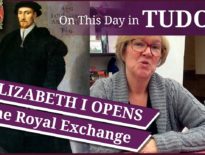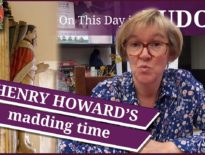On this day in Tudor history, 22nd January 1554, Thomas Wyatt the Younger met with fellow conspirators at his home of Allington Castle in Kent. The purpose of their meeting was to make final plans for their uprising against Queen Mary I and her decision to marry Philip of Spain.
This rebellion would come to be known as Wyatt's Rebellion, although the leader at the start appears to have been Sir James Croft.
Find out all about Wyatt's Rebellion and what happened in this talk.
Also on this day in Tudor history, 22nd January 1552, Edward Seymour, former Lord Protector, was executed. Find out more in this video from last year:
Here are the other videos I mentioned:
Also on this day in history:
- 1528 – Henry VIII and Francis I declared war on Charles V, Holy Roman Emperor.
- 1561 - Birth of Francis Bacon, Viscount St Alban, the Elizabethan Lord Chancellor, politician, philosopher, author and scientist, at York House in the Strand, London. Bacon is known as "the Father of the Scientific method" and developed an investigative method, the Baconian method, which he put forward in his book Novum Organum in 1620. Some people (Baconians) believe that Francis Bacon was the true author of William Shakespeare's plays.
- 1575 – Death of James Hamilton, 2nd Earl of Arran and Duke of Châtelherault, at Kinneil. Arran was appointed Regent for the infant Mary, Queen of Scots after James V's death in 1542, but surrendered the regency to Mary's mother, Mary of Guise in 1554.
- 1613 – Death of Sir David Williams, Serjeant-at-Law in Elizabeth I's reign and Puisne Justice of the King's Bench in James I's reign, from a fever at Kingston House, Kingston Bagpuize, Berkshire. His body was buried at St John's Chapel, Brecon, and his entrails were buried at Kingston.
Transcript:
On this day in Tudor history, 22nd January 1554, Thomas Wyatt the Younger, son of poet and diplomat Thomas Wyatt the Elder, met with fellow conspirators at his home of Allington Castle in Kent. The purpose of their meeting was to make final plans for their uprising against Queen Mary I and her decision to marry Philip of Spain, an uprising that would become known as Wyatt’s Rebellion.
As historian Ian W Archer explained in an article on Thomas Wyatt the Younger, “The anomalous position of a king regnant crystallized fears about how Philip might use his powers within England; the possibility that England might become another Habsburg milch cow was very real; and there was a real risk of a succession struggle on Mary's death”, and even members of Mary I's privy council were concerned about the Spanish match and were putting forward Edward Courtenay, Earl of Devon, as a match.
Two months earlier, in November 1553, Parliament had tried to dissuade the queen from her marriage plans, but she had made up her mind and wouldn’t budge. Some men decided that a military coup might be the only way to prevent the marriage. On the 26th November 1553, a group of men including Wyatt, Sir Peter Carew, Sir Edward Rogers, Sir Edward Warner, Sir William Pickering, Sir Nicholas Throckmorton, Sir James Croft, Sir George Harper, Nicholas Arnold, William Thomas, and William Winter, met in London. Archer writes of how the leader at this point was probably Croft and not Wyatt.
In December 1553, Henry Grey, Duke of Suffolk, father of the imprisoned former queen, Lady Jane Grey, joined the rebel group, and plans were put into action. The rebels planned a simultaneous rising in four different locations on Palm Sunday, 18th March 1554. Sir Peter Carew was to lead a rising in the West country, Sir James Croft was to lead one in Herefordshire, the Duke of Suffolk was to lead one in the Midlands, and Wyatt was to lead one in Kent. All agreed to this plan, but there were disagreements over Mary’s fate. William Thomas wanted Mary assassinated, whereas others, like Wyatt, just wanted her deposed. Mary would then be replaced with her half-sister, Elizabeth, who would marry Englishman, Edward Courtenay, Earl of Devon.
Unfortunately for the rebels, the privy council had got wind of trouble brewing by the end of December 1553, and on 21st January 1554, Edward Courtenay told Stephen Gardiner, Bishop of Winchester and Mary I’s Lord Chancellor, of the rebels’ plans. This meant that the rebels were forced into action earlier than planned. While Carew was busy spreading dissent in Devon, Wyatt called a meeting at Allington Castle on this day in 1554 to organise the Kent part of the rebellion. Three days later, on 25th January 1554, Wyatt raised his standard in the town of Maidstone, while his fellow Kentish rebels proclaimed for the rebellion in Rochester, Tonbridge, Malling and Milton.
On 28th January, the government sent 600 men from London to Kent under the leadership of Thomas Howard, 3rd Duke of Norfolk. It wasn’t enough. They were far outnumbered by Wyatt’s forces and many men mutinied, joining the rebel cause. On 30th January, Wyatt and his men besieged Cooling Castle, owned by George Brooke, 9th Baron Cobham, who had withdrawn to his castle after the Duke of Norfolk’s forces had mutinied and dispersed. According to historian C S Knighton, Cobham claimed that he had fought valiantly against the rebels for seven hours before surrendering to them, but Knighton points out that his resistance was actually a “pretence” and he joined the rebels willingly. At this point, things were looking very good for Wyatt and his men, who then marched on to London.
On 1st February 1554, Mary I gave a rousing speech at Guildhall in London to rally Londoners to her cause and when Wyatt and his men reached London on 3rd February, they found the City guarded and barricaded. Wyatt changed his plan, moving from Southwark to Kingston, and was successful in entering Kingston on 6th February. But there, he encountered problems: the bridge over the Thames needed repairing before it could be crossed and his siege artillery became bogged down and had to be abandoned. Archer writes of how “Some observers doubted the loyalty of the queen's commanders, as they apparently let Wyatt advance unmolested” but Wyatt was left alone because he was actually being “lured into a trap”. By the time Wyatt and his troops reached Ludgate, Mary's force had barred the gates and the rebels were forced into turning around and heading to Temple Bar, where Mary's troops were waiting for them. With his men surrendering and swearing allegiance to the queen, Wyatt was forced to surrender, and he was arrested by Sir Maurice Berkeley and taken to the Tower of London.
On 15th March 1554, Thomas Wyatt the Younger was tried for high treason at Westminster Hall. He denied plotting the assassination of Mary I and refused to implicate Mary’s half-sister, Elizabeth. He was found guilty of treason and was executed by beheading on 11th April 1554. His body was quartered before his head and body parts were taken to Newgate, where they were parboiled. His body parts were nailed up around the city, and his head was placed on a gibbet at St James’s. It is not known what happened to his head, as it was subsequently stolen from the gibbet.
On 18th March 1554, Mary I’s half-sister, Elizabeth, was escorted to the Tower of London and imprisoned there while Mary’s council tried to implicate her in the rebellion. Fortunately, they couldn’t, and she was released in May 1554. However, Lady Jane Grey, whose father had been involved in Wyatt’s Rebellion, was not so lucky. Jane and her husband Guildford Dudley were executed on 12th February 1554. Her father was executed on the 23rd February 1554.



I hope you’re feeling better, Claire! Take it easy. (And you sounded fine. Your videos are great). Michelle t